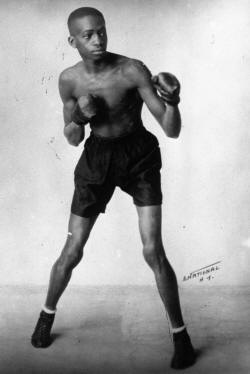

Queer Places:
Amador Guerrero Cemetery, Panama City
 Alfonso Teofilo Brown (July 5, 1902 – April 11, 1951), better known as Panama Al Brown, was a Panamanian professional boxer. He made history by becoming boxing's first Latin American world champion, and is widely regarded as one of the greatest bantamweight boxers in history.[2][3]
Brown won the NYSAC and lineal bantamweight titles in 1929 after defeating Gregorio Vidal. In 1930 he won both the NBA and IBU bantamweight titles, after defeating Johnny Erickson and Eugène Huat. After relocating to Paris, France, Brown became known within the gay nightlife of the time for his flamboyant lifestyle and his interest in the arts, performing in a cabaret.
As an Afro-Panamanian in the US, Brown faced racial barriers throughout his boxing career,[4] and had been stripped of the NYSAC and NBA titles by 1934. He held the IBU title until 1935, when he lost it to Baltasar Sangchili.
In 1938, Brown fought for the IBU bantamweight title again in a rematch with Sangchili, winning on points. He continued to box until 1942, but failed to achieve the same level of success he had previously enjoyed. In 2002, Brown was named one of the 80 best fighters of the past 80 years by The Ring magazine.[5] He currently ranks #5 in BoxRec's ranking of the greatest bantamweight boxers in history.[6] He has been inducted into the International Boxing Hall of Fame.[7]
Alfonso Teofilo Brown (July 5, 1902 – April 11, 1951), better known as Panama Al Brown, was a Panamanian professional boxer. He made history by becoming boxing's first Latin American world champion, and is widely regarded as one of the greatest bantamweight boxers in history.[2][3]
Brown won the NYSAC and lineal bantamweight titles in 1929 after defeating Gregorio Vidal. In 1930 he won both the NBA and IBU bantamweight titles, after defeating Johnny Erickson and Eugène Huat. After relocating to Paris, France, Brown became known within the gay nightlife of the time for his flamboyant lifestyle and his interest in the arts, performing in a cabaret.
As an Afro-Panamanian in the US, Brown faced racial barriers throughout his boxing career,[4] and had been stripped of the NYSAC and NBA titles by 1934. He held the IBU title until 1935, when he lost it to Baltasar Sangchili.
In 1938, Brown fought for the IBU bantamweight title again in a rematch with Sangchili, winning on points. He continued to box until 1942, but failed to achieve the same level of success he had previously enjoyed. In 2002, Brown was named one of the 80 best fighters of the past 80 years by The Ring magazine.[5] He currently ranks #5 in BoxRec's ranking of the greatest bantamweight boxers in history.[6] He has been inducted into the International Boxing Hall of Fame.[7]
Brown quickly fell in love with Paris, and as a result spent much of his life there. He was noted for dressing elegantly, and enjoyed the night life of the city, frequenting bars and jazz clubs. Brown was gay and was involved in a long-term romantic relationship with Jean Cocteau.[10][22][23] He owned a number of cars including a 1929 Packard 645 Sport, and several Bugatti's.[24] He joined Josephine Baker's La Revue Nègre as a tap-dancer, and made his cabaret debut as a song-and-dance man at the Caprice Viennoise.[25] During the early 1930s Brown contracted syphilis, and suffered from sores on his back. He recovered well enough to continue his boxing career, though without antibiotics it remains unknown as to what extent he overcame the infection.[10]
With the advent of the Second World War, Brown moved to the United States, settled in Harlem and tried to find work of the cabaret sort he performed in Paris when not fighting. There was none and before long he was fighting again, but not well.[9] Brown went on fighting until 1942, challenging unsuccessfully for the Panamanian Featherweight title on September 30, 1942, when he drew with Leocadio Torres, but retiring as a winner, defeating Kid Fortune by a decision in ten rounds on December 4 of the same year. Not long after, he was arrested for using cocaine and deported for a year.[2] He went back to New York afterward and, in his late 40s, took a lot of beatings while serving as a sparring partner for up-and-comers at a gym in Harlem, making a dollar a round. Brown died penniless of tuberculosis in New York City in 1951. He had fainted on 42nd Street. The police thought he was drunk and took him to the station. Eventually he was transferred to Sea View Hospital. He died there on April 11,[2] unaware that not long before, one of the newspapers in Paris had begun talks about organizing a fund drive to pay for his trip home. During five years of investigation, Spanish painter Eduardo Arroyo wrote a biography of Panama Al Brown, titled Panama Al Brown, 1902-1951, first published by Edition Jean-Claude Lattès, Paris, in 1982. Panama Al Brown's final record is believed to have been 123 wins, 18 defeats and 10 draws, with 55 knockouts, placing him in the exclusive list of boxers who have won 50 or more wins by knockout. He was the recognized bantamweight world champion for six years and over that time made 10 title defenses against 8 different contenders, the best bantamweights and featherweights of his era.[20][21]
My published books: